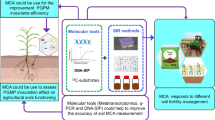Abstract
The use of indicators in soil monitoring schemes to detect changes in soil quality is receiving increased attention, particularly the application of soil biological methods. However, to date, the ability to compare information from different laboratories applying soil microbiological techniques in broad-scale monitoring has rarely been taken into account. This study aimed to assess the consistency and repeatability of two techniques that are being evaluated for use as microbiological indicators of soil quality: multi-enzyme activity assay and multiple substrate-induced respiration (MSIR). Data were tested for intrinsic (within-assay plate) variation, inter-laboratory repeatability (geometric mean regression and correlation coefficient) and land-use discrimination (principal components analysis). Intrinsic variation was large for both assays suggesting that high replicate numbers are required. Inter-laboratory repeatability showed diverging patterns for the enzyme assay and MSIR. Discrimination of soils was significant for both techniques with relatively consistent patterns; however, combined laboratory discrimination analyses for each technique showed inconsistent correspondence between the laboratories. These issues could be addressed through the adoption of reliable analytical standards for biological methods along with adequate replication. However, until the former is addressed, dispersed analyses are not currently advisable for monitoring schemes.




Similar content being viewed by others
References
Anderson JPE, Domsch KH (1978) A physiological method for the quantitative measurement of microbial biomass in soils. Soil Biol Biochem 10:215–221. doi:10.1016/0038-0717(78)90099-8
Bardgett RD, Usher MB, Hopkins DW (2005) Biological Diversity and Function in Soils. Cambridge University Press, Cambridge
Bastida F, Moreno J, Hernández T, Garcia C (2006) Microbiological activity in a soil 15 years after its devegetation. Soil Biol Biochem 38:2503–2507. doi:10.1016/j.soilbio.2006.02.022
Bending GD, Turner MK, Rayns F, Marx M, Wood M (2004) Microbial and biochemical soil quality indicators and their potential for differentiating areas under contrasting agricultural management regimes. Soil Biol Biochem 36:1785–1792. doi:10.1016/j.soilbio.2004.04.035
Black HIJ, Wood C, Parekh N, Chamberlain PM, Scott A, Ritz K, Harris JA, Campbell CD, Towers W (2008) Prioritising biological indicators of soil quality for deployment in a national-scale soil monitoring scheme. Report on Project SP0529. Defra, London
Breure AM, Mulder C, Rutgers M, Schouten AJ, de Zwart D (2003) A Biological Indicator for Soil Quality. OECD, Paris
British Standard BS7755 (1995); ISO 10390, 1994; Soil Quality, Part 3, Chemical Methods, section 3.2, Determination of pH
Campbell CD, Chapman SJ, Cameron CM, Davidson MS, Potts JM (2003) A rapid microtitre plate method to measure carbon dioxide evolved from carbon substrate amendments so as to determine the physiological profiles of soil microbial communities by using whole soil. Appl Environ Microbiol 69:3593–3599. doi:10.1128/AEM.69.6.3593-3599.2003
Campbell CD, Cameron CM, Bastias BA, Chen C, Cairney JWG (2008) Long term repeated burning in a wet sclerophyll forest reduces fungal and bacterial biomass and responses to carbon substrates. Soil Biol Biochem 40:2246–2252. doi:10.1016/j.soilbio.2008.04.020
Degens BP, Harris JA (1997) Development of a physiological approach to measuring the catabolic diversity of soil microbial communities. Soil Biol Biochem 29:1309–1320. doi:10.1016/S0038-0717(97)00076-X
Degens BP, Vojvodic-Vukovic M (1999) A sampling strategy to assess the effects of land use on microbial functional diversity in soils. Aust J Soil Res 37:593–601
Fließbach A, Oberholzer H-, Gunst L, Mäder P (2007) Soil organic matter and biological soil quality indicators after 21 years of organic and conventional farming. Agric Ecosyst Environ 118:273–284. doi:10.1016/j.agee.2006.05.022
Francaviglia R (ed) (2004) Agricultural Soil Erosion and Soil Biodiversity: Developing Indicators for Policy Analyses. OECD, Paris
Hodgson JM (ed) (1997) Soil survey field handbook. Soil Survey Technical Monograph No. 5, Silsoe, UK
ISO (1997) ISO 14240-2:1997 Soil quality—determination of soil microbial biomass—Part 2: Fumigation-extraction method
ISO (2002) ISO16072:2002 Soil quality—laboratory methods for determination of microbial soil respiration
ISO (2005) ISO 23753-1:2005 Soil quality—Determination of dehydrogenase activity in soils—Part 1: method using triphenyltetrazolium chloride (TTC)
ISO (2006) ISO 23611-1:2006 Soil quality—sampling of soil invertebrates—Part 1: hand-sorting and formalin extraction of earthworms
Jenkinson DS, Powlson DS (1976) The effects of biocidal treatments on metabolism in soil-V. A method for measuring soil biomass. Soil Biol Biochem 8:209–213. doi:10.1016/0038-0717(76)90005-5
Kandeler E, Mosier AR, Morgan JA, Milchunas DG, King JY, Rudolph S, Tscherko D (2006) Response of soil microbial biomass and enzyme activities to the transient elevation of carbon dioxide in a semi-arid grassland. Soil Biol Biochem 38:2448–2460. doi:10.1016/j.soilbio.2006.02.021
Kubat J (2003) Incidence and activities of the soil micro-organisms as an indicator of soil biodiversity. OECD, Paris
Lalor BM, Cookson WR, Murphy DV (2007) Comparison of two methods that assess soil community level physiological profiles in a forest ecosystem. Soil Biol Biochem 39:454–462. doi:10.1016/j.soilbio.2006.08.015
Marx M, Wood M, Jarvis SC (2001) A microplate fluorimetric assay for the study of enzyme diversity in soils. Soil Biol Biochem 33:1633–1640. doi:10.1016/S0038-0717(01)00079-7
Molecular Devices UK (2008). http://www.moleculardevices.com/ (available on 30/03/2009)
Oliveira A, Pampulha ME (2006) Effects of long-term heavy metal contamination on soil microbial characteristics. J Biosci 102:157–161
Ros M, Klammer S, Knapp B, Aichberger K, Insam H (2006) Long-term effects of compost amendment of soil on functional and structural diversity and microbial activity. Soil Use Manage 22:209–218. doi:10.1111/j.1475-2743.2006.00027.x
Sokal RR, Rohlf FJ (1981) Biometry. W.H. Freeman, New York
STATISTICA (2004) STATISTICA v6.1. StatSoft Inc, 1984-2004
Wakelin SA, Macdonald LM, Rogers SL, Gregg AL, Bolger TP, Baldock JA (2008) Habitat selective factors influencing the structural composition and functional capacity of microbial communities in agricultural soils. Soil Biol Biochem 40:803–813. doi:10.1016/j.soilbio.2007.10.015
Winding A, Hendriksen NB (2007) Comparison of CLPP and enzyme activity assay for functional characterization of bacterial soil communities. J Soils Sediments 7:411–417. doi:10.1065/jss2007.11.262
Acknowledgements
The work was funded by the UK Department of Environment, Food and Rural Affairs (Defra). We thank Christian Poll and Ellen Kandeler, Universität Hohenheim, for liaison regarding the enzyme fluorimetry.
Author information
Authors and Affiliations
Corresponding author
Rights and permissions
About this article
Cite this article
Creamer, R.E., Bellamy, P., Black, H.I.J. et al. An inter-laboratory comparison of multi-enzyme and multiple substrate-induced respiration assays to assess method consistency in soil monitoring. Biol Fertil Soils 45, 623–633 (2009). https://doi.org/10.1007/s00374-009-0374-y
Received:
Revised:
Accepted:
Published:
Issue Date:
DOI: https://doi.org/10.1007/s00374-009-0374-y




